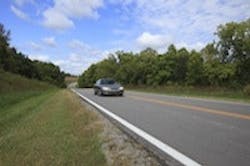Missouri DOT Plans for More Fall Broadleaf Applications to Prepare for Spring
Winters typically are a time of looking ahead for roadside crews, a time of preparation and evaluation for the following spring’s roadside vegetation management plans. This winter, the Missouri Department of Transportation (MoDOT) is taking more action instead to get ahead of the game.
“Typically what we’ve done in the past has just been doing some prep work, evaluating the different routes on what our vegetation management plan would be the following year,” said Rand Swanigan, roadside management specialist with MoDOT. Previous winter activities also focused on issues such as analyzing equipment and applying limited grass treatments.
New this year for MoDOT crews is the implementation of light broadleaf control applications in the late fall and winter. “Time is such a critical thing going into the spring, and in the past we’ve really been focused on the mindset that spring was the time for broadleaf treatments,” he said. But with many problem weeds on roadsides continuing to remain green and active even into cold weather, Swanigan says the department is now encouraging more light applications of herbicides during suitable fall weather days to allow for easier management later on.
In Missouri, the unpredictable spring seasons often present challenges for roadside crews. Heavy winds, wet roads and more can limit the crews’ accessibility of getting out onto the roadsides when needed. “Time-wise, there’s also so many other projects that are going on at the same time that we’ve got limited personnel and limited resources [in the spring],” Swanigan said.
The fall applications also reduce any concerns MoDOT would have about applying herbicides in the spring to roadsides with adjoining crop fields, because at that point in the fall, any crops sensitive to herbicides would have already been harvested.
For its roadside vegetation management plans MoDOT is also expecting to use more of one of the recently introduced DuPont herbicide, Perspective, which the department has previously tested. “What we like about Perspective is that it gives us some carryover from the fall application to allow us good broadleaf control into the following spring and well into the summer,” Swanigan said. Perspective is on the department’s bid list, and more personnel equipped with the herbicide are being deployed for broadleaf control.
By focusing more on vegetation management in the fall, MoDOT hopes to be more than prepared when the weather changes.
